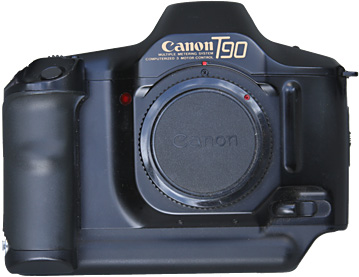
Lens Mount: FD bayonet/breech
Film type: 35mm
Approx. dates of manufacture: 1986-1998
Battery: 4 AAs
Approx. original price: $500
Approx. street value: Moderately high
I've often read that the North American P-51 Mustang, a highly regarded fighter airplane from World War II, is often considered the apex of piston-engine aircraft design. Not only was the P-51 among the very best, it was likely that piston-engine aircraft couldn't get much better. The future, therefore, went to jets.
I've similar-sounding comments about this, Canon's last major manual-focus camera. It is by all rights a killer. It has been twenty years since it was introduced and it's still highly regarded. This wasn't just the top of the T-series line, it was the replacement of the Canon A-1 as the gee whiz, do-everything, pro-caliber machine. While the New F-1 had been redesigned and updated to appeal to pros, it was also very conservative and meant to appeal to people who liked the old, heavy all-metal bodies, limited automation, and such. The A-1 had been the professional tier Buck Rogers camera, using weight-saving and compact strategies that had been introduced on the AE-1. While it was considered a technological marvel in 1976, the A-1 aged rapidly and looked positively dull by the early 80s.
If you really want to see how far camera technology advanced in a single decade, compare the A-1 and the T90, both of which were cutting edge in their respective times. The A-1 could accept a motor drive; the T90 had it built in. The A-1 had in-viewfinder LED readouts for shutter speed and aperture, a flash-ready light, and warning lights; the T90 had shutter speed, aperture, AE lock, manual, flash ready, exposure compensation, remaining frame count, exposure scale and multi-spot reading among other things. The A-1 had interchangable viewscreens but you had to send it in to the shop to have them installed professionally; the T90's could be swapped by the user. The A-1 had a top shutter speed of 1/1000; the T90 topped out at 1/4000th. The A-1 had six modes: full manual, aperture priority, shutter priority, full-auto, auto with flash, and TTL stopped-down, all with center-weighted averaging; The T90 had all that plus the semi-spot and spot-metering. The A-1 took a little 6v cell, but needed a dozen AAs to run the motor drive; the T90 used 4 AAs and that included the winder. The A-1 took an optional "Data back" which flashed the date onto the film. The T90 took a command back that allowed all sorts of additional control, like timed auto-exposures.
.jpg) The list is endless. Long story short: the T90 isn't just Canon's flagship from the 1980s, it's Canon's P-51 Mustang. It's arguably the most advanced and capable manual-focus camera made (or at least it's in close company with the Nikon F5).
The list is endless. Long story short: the T90 isn't just Canon's flagship from the 1980s, it's Canon's P-51 Mustang. It's arguably the most advanced and capable manual-focus camera made (or at least it's in close company with the Nikon F5).
Another noteworthy thing about it is that it launched the new look and feel for Canon's SLRs. It was really the first EOS camera, except it lacked autofocus. But the look and feel of the body design is the way Canon moved. Everything else looks old-school in comparison.
Mine came from a thrift-shop's online auction and was DOA when I got it; that's the peril of buying things sight-unseen, but I knew the risk when I took it and I knew they didn't test their cameras. After a lot of futzing around, I finally found some lightly corroded contacts on the battery holder. I cleaned up the contacts with a little sandpaper (pencil erasers wouldn't do it), checked it with a meter to make sure I was getting power, and popped it back in. Voila. The camera came back to life.
Always check your batteries.
For more information: Canon Camera Museum
Modern Photography magazine camera test: July 1986
One of Modern Photography magazine's Top Cameras
Camera manual: Orphan Cameras.com



